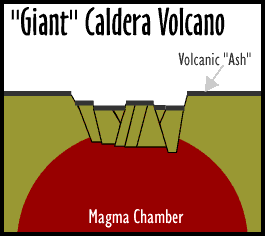

  |
 Types of Volcanoes Types of VolcanoesTwo important types of volcano are difficult to recognize, especially when they are very large. The first of these is the "giant caldera" (see left). Calderas, which are simply circular depressions, are found on the summits of many volcanoes. "Giant" calderas are the largest of these: huge craters up to many tens of miles across. Giant Calderas form by collapse (see animation) in gigantic eruptions that spew volcanic rocks out hundreds or even a thousand miles in all directions. Sometimes the calderas are so filled with lava and volcanic ash that there is no recognizable depression at all. These can only be found by carefully locating the big fractures or "faults" in the ground that mark the edges of the caldera. One such caldera nearly fills Yellowstone National Park. In other cases, the edges of the caldera remain as large cliffs or ridges surrounding the central depression. However, the depression is so large that a person standing in the middle of it could hardly see the edges and would only recognize them if they were pointed out. These giant calderas can best be seen in images taken from space, like the one of the Valles Caldera in New Mexico (below,left).
[ Types of Volcanoes: page 1 / page 2
] [ Types
of Lava ] [ Home ] [ Teacher Pages ] [ Modules & Activities ] |
HTML code by Chris Kreger
Maintained by ETE Team
Last updated November 10, 2004
Some images © 2004 www.clipart.com
Privacy Statement and Copyright © 1997-2004 by Wheeling Jesuit University/NASA-supported Classroom of the Future. All rights reserved.
Center for Educational Technologies, Circuit Board/Apple graphic logo, and COTF Classroom of the Future logo are registered trademarks of Wheeling Jesuit University.